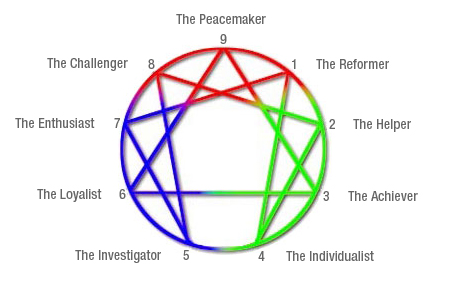- MBTI
- IEI
- Enneagram
- 6w5 sp/sx

There are nine personality types in the Enneagram. Each person has one basic type, which is defined by our basic fears, desires, and motivations. For some people, identifying these basic drives is difficult, which is why many methods use the manifesting traits to type people. However, the key here is that the Enneagram is meant to explain why we do what we do, not what. Here is a brief description of each type.
One - The Perfectionist, The Reformer
Hallmark characteristic: constant internal criticism towards oneself
Worldview: The world is an imperfect place. I work toward perfection.
Basic Fear: Of being corrupt/evil, defective
Basic Desire: To be good, to have integrity, to be balanced
Two - The Giver, The Helper
Hallmark characteristic: need to become indispensable to another individual (or individuals)
Worldview: People depend on my help. I am needed.
Basic Fear: Of being unwanted, unworthy of being loved
Basic Desire: To feel loved
Three - The Performer, The Achiever
Hallmark characteristic: "I am my image; I am what I do."
Worldview: The world values a champion. I must avoid failure.
Basic Fear: Of being worthless
Basic Desire: To feel valuable and worthwhile
Four - The Romantic, The Individualist
Hallmark characteristic: pervasive sense of something vital missing in life
Worldview: Something is missing. Others have it. I have been abandoned.
Basic Fear: That they have no identity or personal significance
Basic Desire: To find themselves and their significance (to create an identity)
Five - The Observer, The Investigator
Hallmark characteristic: detachment; viewing the world as an uninvolved observer
Worldview: The world is invasive. I need privacy to think and to refuel my energies.
Basic Fear: Being useless, helpless, or incapable
Basic Desire: To be capable and competent
Six - The Trooper, The Loyal Skeptic
Hallmark characteristic: pessimism; seeing the worst-case scenarios
Worldview: The world is a threatening place. I question authority.
Basic Fear: Of being without support and guidance
Basic Desire: To have security and support
Seven - The Optimist, The Epicure, The Enthusiast
Hallmark characteristic: seeing the good in everything; reframing negatives into positives
Worldview: The world is full of opportunity and options. I look forward to the future.
Basic Fear: Of being deprived and in pain
Basic Desire: To be satisfied and content—to have their needs fulfilled
Eight - The Boss, The Straight Shooter, The Challenger
Hallmark characteristic: bigger-than-life energy; seems to take up space regardless of stature
Worldview: The world is an unjust place. I defend the innocent.
Basic Fear: Of being harmed or controlled by others
Basic Desire: To protect themselves (to be in control of their own life and destiny)
Nine - The Mediator, The Peacemaker
Hallmark characteristic: overlooking own agenda to go with the flow; passive merging with others' desires
Worldview: The world won't value my efforts. Stay comfortable. Keep the peace.
Basic Fear: Of loss and separation
Basic Desire: To have inner stability "peace of mind"
-adapted from The Everyday Enneagram, The Enneagram in Love and Work, and enneagraminstitute.com
Each person also has a primary instinct. They work more underneath the basic 9 personalities, and tend to 'flavor' them. They are as follows:
Self-preservational
strong concern with comfort, health, and security
tendency to be practical, serious, and introverted
Sexual (intimacy) - strong concern with intimacy, personal chemistry, and attraction/repulsion
tendency to be intense, aggressive, and competitive
Social - strong concern with group connection, social dynamics/situation, and one's status in groups
tendency to be friendly, open, and socially engaging
-adapted from enneagraminstitute.com
These three are separate from the 9 types; however, they do tend to shape the overall personality manifestation.
There's much more to say about the theory, but I'm not going into the details here. Just know that there are secondary types (known as wings and instinctual stackings) for each part of the theory. A more in-depth introduction can be found here:
http://www.enneagraminstitute.com/intro.asp
Also, further reading:
On type stackings & combinations of type and instinct - http://ocean-moonshine.net/e1428573...er_op=view_page&PAGE_id=42&MMN_position=80:80
On descriptions of the different wing combinations - http://theenneagram.blogspot.com/
A thread of references for enneagram - http://www.typologycentral.com/forums/enneagram/23463-ultimate-enneagram-reference-thread.html
Last edited:
